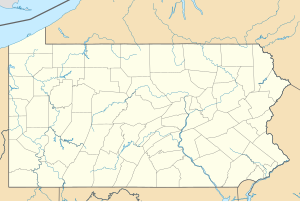Soldiers and Sailors Memorial Bridge
| State Street Bridge | |
| Soldiers and Sailors Memorial Bridge | |
|
HAER photo of the State Street Bridge
|
|
| Country | United States |
|---|---|
| State | Pennsylvania |
| County | Dauphin |
| City | Harrisburg |
| Road | SR 3014 (State Street) |
| Crosses | Amtrak / Norfolk Southern tracks |
| Coordinates | 40°16′0″N 76°52′42″W / 40.26667°N 76.87833°WCoordinates: 40°16′0″N 76°52′42″W / 40.26667°N 76.87833°W |
| Length | 1,312 ft (400 m) |
| Width | 80 ft (24 m) |
| - Road width | 56 ft (17 m) |
| Architect | William Gehron, Sidney F. Ross |
| Design | Elliptical, deck arch bridge |
| Material | Concrete |
| Completed | August 22, 1930 |
| - Added to NRHP | June 22, 1988 |
| Governing Body | PennDOT |
| NBI # | 223014003001900 |
| NRHP # | 88000761 |
| HAER # | PA-456 |
| ADT | 8,182(2009) |
| Load | 36 short tons (33 t) |
| MPS | Highway Bridges Owned by the Commonwealth of Pennsylvania, Department of Transportation TR |
The State Street Bridge, also known as the Soldiers and Sailors Memorial Bridge, is a 1,312-foot (400 m) concrete, deck arch bridge that spans Pennsylvania Route 230 and Paxton Creek in Harrisburg, Pennsylvania. The bridge was completed in 1930 and was intended to be the principal entrance into downtown Harrisburg and the Pennsylvania State Capitol Complex from the east.
The bridge was listed on the National Register of Historic Places on June 22, 1988, and was documented by the Historic American Engineering Record in 1997.
After the Pennsylvania State Capitol building burned to ground in 1897, plans were drawn up to improve and expand the park that surrounds the Capitol building. The plans were for a more impressive Capitol building that would prevent other Pennsylvania cities like Philadelphia from challenging Harrisburg's claim as the seat of the state government. After the land that was necessary for the expansion was acquired in 1916, Arnold Brunner was hired to design the plans for the construction and landscaping of the new buildings. Planning was interrupted by World War I.
After the war, in 1919, it was decided to make the bridge a memorial to the armed forces of the United States and Pennsylvania that had fought in the war. The Pennsylvania General Assembly passed an act authorizing the construction of the bridge on July 18, 1919. In 1926, William Gehron and Sidney Ross revised the plans that Brunner had made for the bridge in 1921 after his death in 1925. Changes they made included a more massive bridge and taller, "more streamlined" pylons.
...
Wikipedia


